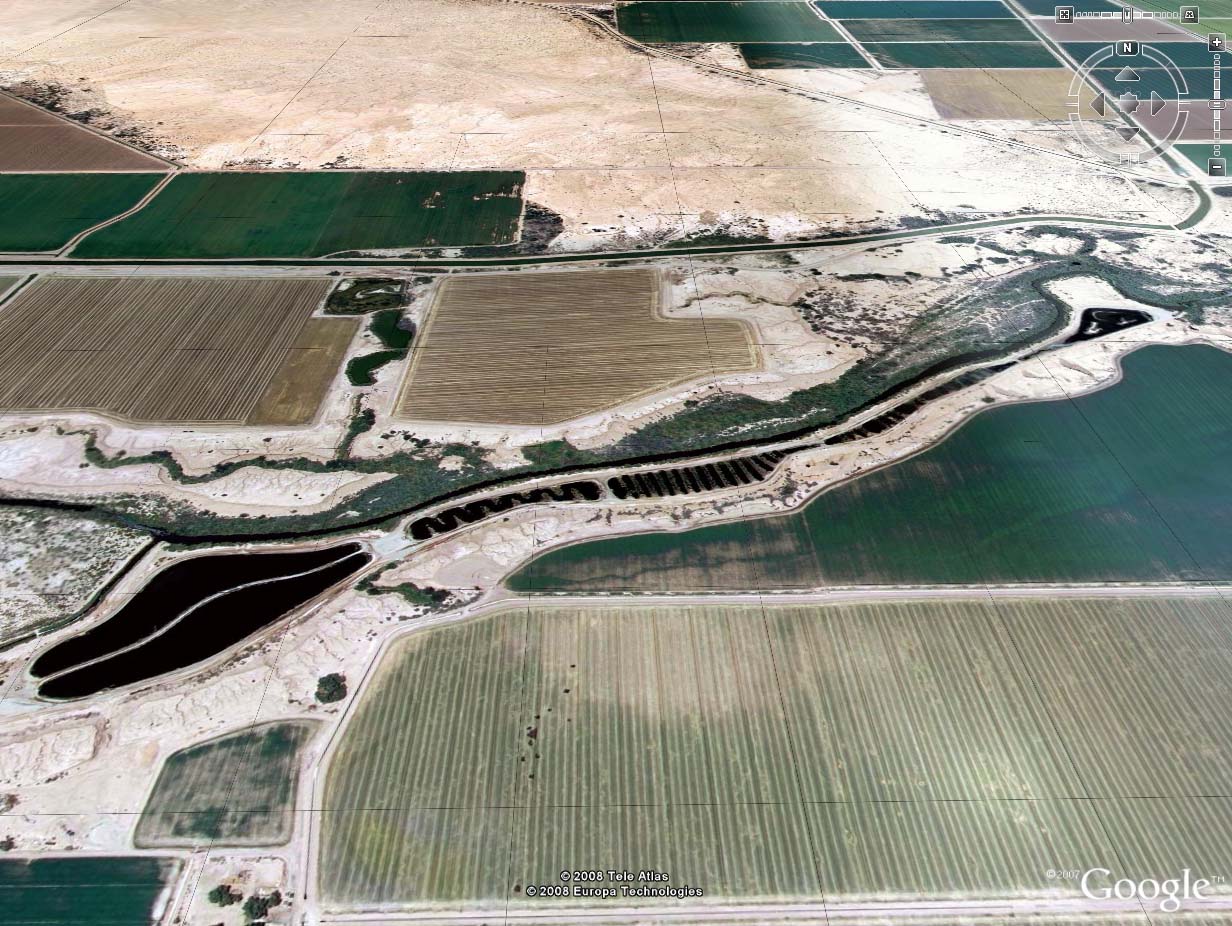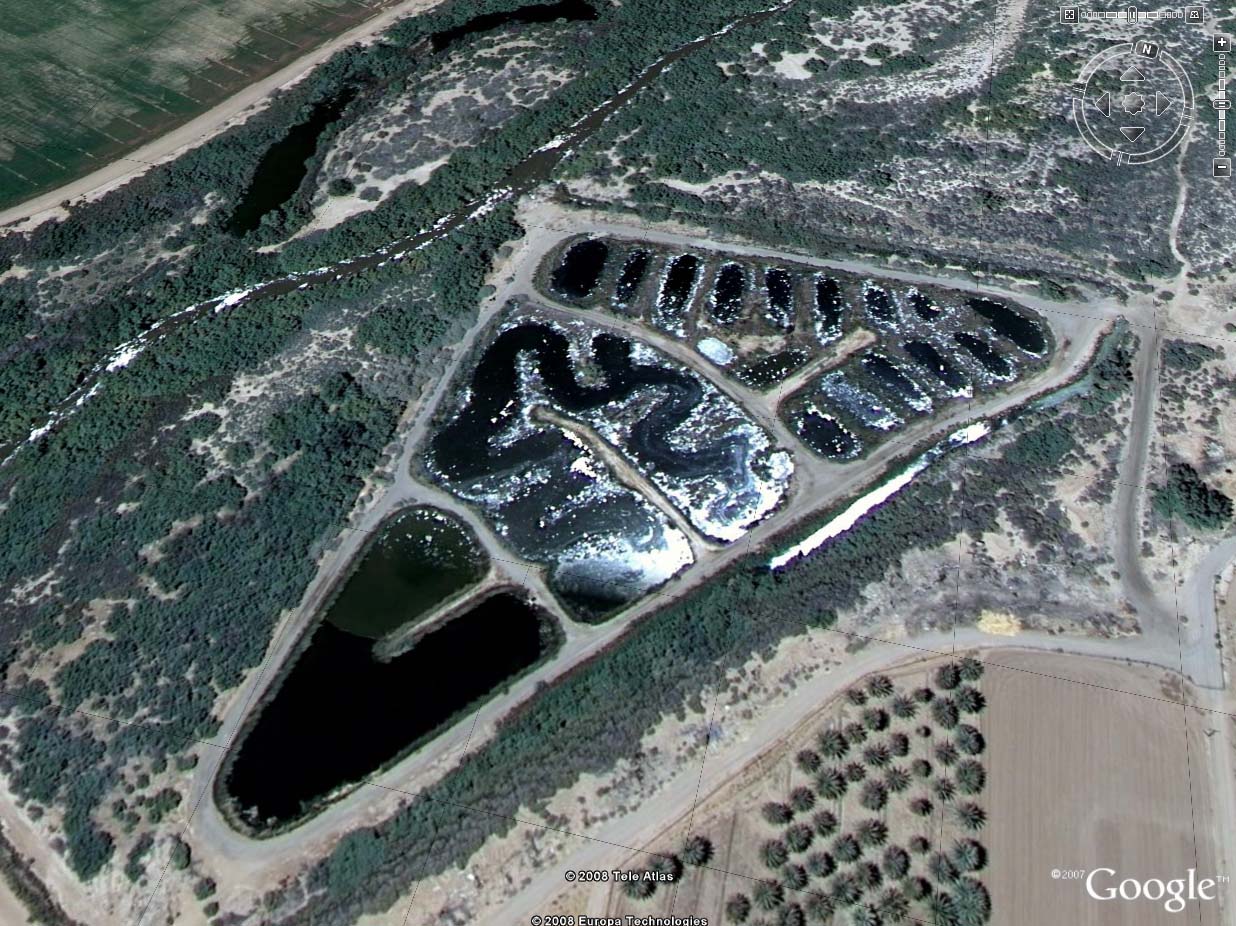 Imperial wetland IMPERIAL, CALIFORNIA
WHY IS IT INNOVATIVE? The New River Wetlands Project is innovative because it uses constructed wetlands in the desert to treat polluted surface water. Although wetlands have traditionally been nature's filters, over 90% of natural wetlands have been lost in California, leading to loss of habitat and degradation of water quality. While wetlands have been constructed in the border region with the intent of restoring habitat, the use of constructed wetlands for the main purpose of improving water quality is less common. Typically, wetlands constructed to improve water quality have wastewater as their source. A unique feature of the New River Wetlands Project is the use of surface water, which requires sediment removal as a key aspect of treatment. While research has documented the effectiveness of wetlands in improving water quality in other parts of North America, the Salton Sea region has a unique climate, with extreme heat (an annual average daily maximum temperature of 88 degrees) and little precipitation (less than three inches per year). Localized testing was needed to evaluate the use of wetlands to improve water quality in this region. Other important aspects of the project are creation of habitat for fish and birds, and educational outreach that has involved hundreds of students in classroom activities, field trips, and work days.
ORGANIZATIONS INVOLVED In early 1997, Desert Wildlife Unlimited, a local organization, looked for a solution to the pollution problem. This group worked with local, state, and federal agencies to obtain grant funds. Under the auspices of Desert Wildlife Unlimited, the Citizen's Congressional Task Force on the New River was formed to develop the project. The project has been implemented with participation from a variety of entities, including Citizen's Congressional Task Force on the New River Desert Wildlife Unlimited Imperial Irrigation District Bureau of Reclamation County of Imperial California Regional Water Quality Control Board California Department of Fish and Game U.S. Fish and Wildlife Service U.S. Geological Survey U.S. Environmental Protection Agency Salton Sea Authority PROBLEM STATEMENT Water quality is impaired by the presence of high levels of suspended sediments, nutrients (nitrogen and phosphorus), selenium, and coliform bacteria. Sediments, suspended solids, and turbidity of the New and Alamo Rivers exceed objectives established by the state Regional Water Quality Control Board, Colorado River Basin Region. The New and Alamo Rivers acquire these pollutants from agricultural drainage and urban sewage, especially sewage from Mexico. The concern is that pollutants carried by the New and Alamo Rivers are degrading the Salton Sea, a saline lake in the Sonoran desert located 40 miles north of the international boundary. These two rivers account for 80% of the flow into the Salton Sea. The Salton Sea is a vital link for migratory birds on the Pacific Flyway and is considered the nation's most productive fishery. Yet the Salton Sea's survival is at risk due to increasing salinity, pollution, and decreased inflow. Excessive nutrients, including phosphates and nitrates from runoff of agricultural fertilizers and municipal wastewater contribute to eutrophication of the Salton Sea, which has no outlets. Controlling these pollutants is one way to help preserve and restore the Sea. APPROACH Two pilot wetlands were constructed in 2000 to improve water quality in the New and Alamo Rivers. Monitoring of these two sites has been conducted since 2001. The Imperial Wetland, located approximately 13 miles north of the international boundary near Imperial, California, has 22.7 wet acres. The source water is entirely agricultural drainage from the Rice 3 Drain. The site has two sedimentation basins and four wetland cells in series, a capacity of 127 acre-feet, a flow rate of 6 cubic feet per second (cfs), and retention time of 9 days. The Brawley Wetland, near Brawley California, approximately 20 miles north of the border, has 6 wet acres with a capacity of 21 acre-feet. It treats water from the New River. The wetland has one sedimentation basin and two wetland cells in series with a flow rate of 1 cubic foot per second (cfs) and retention time of 7 days. Flowing water enters the wetland where it settles into bottom sediments or is subject to microbially-mediated reactions that may transform contaminants into volatile or bioavailable forms or is incorporated into algae and plants. When eaten by fish and invertebrates, it goes up the food chain. But eventually, these plants and animals die, settling into the sediment. Over the long term, with sediment build-up, there is a permanent sequestration of pollutants in the sediment. Monitoring has been done for several years for the following parameters at wetland inlets and outlets:
Monitoring and analysis were done to characterize the removal of pollutants from the two pilot wetlands to assist in developing designs for other wetlands in the region. The long-term goal of the project is to develop sufficient wetlands along the New and Alamo Rivers to decrease the amount of total suspended solids, nitrogen, phosphorous, and fecal coliforms, and to increase the amount of dissolved oxygen in these streams, therefore benefitting the Salton Sea. WHAT MAKES IT UNIQUELY A BORDER CASE? The New River originates in Mexico, flows through Mexicali, Mexico into Calexico, California and through Imperial County before emptying into the Salton Sea. The New River at the international border is considered one of the most polluted streams in the United States due to sewage arriving from Mexico. The river carries urban runoff, agricultural runoff, and domestic and industrial waste from both countries. According to the Regional Water Quality Control Board, New River flow at the border is about 150- 200 cfs, increasing to 600 cfs where it enters the Salton Sea. The Alamo River also originates in Mexico about 2 miles south of the border. It is dominated by agricultural return flows from the Imperial Valley. The Regional Water Quality Control Board calculates flow at the border at 3-5 cfs, increasing to up to 1000 cfs at the Salton Sea delta. The Salton Sea has important ecological connections with the Colorado River Delta in Mexico. Both are key stops on the Pacific Flyway, linked by the riparian corridors along the Colorado, Hardy, New, and Alamo Rivers. Over 400 bird species are found in this region. The New River Wetland Project is unique to the border region because it treats water pollution arriving from Mexico and is part of a binational ecosystem. RESULTS Both the Brawley and Imperial Wetlands significantly reduced the amount of nitrogen, phosphorous, pathogens (bacteria), and total suspended solids (sediment) in water. Both wetlands removed over 90% of suspended sediments and pathogens (measured as fecal coliform). Over 100 bird species have been found at the wetlands. MEASUREABLE REDUCTION IN POLLUTION
Water quality monitoring conducted from 2001-2007 is summarized in the tables
below:
BENEFITS/SUCCESSES The constructed wetlands provide the following benefits:
FAILURES Some bioaccumulation of selenium in invertebrates, fish, and bird eggs was detected. Organochlorine pesticides were detected in tissue samples from fish and invertebrates. There is a need to further study the risk associated with bioaccumulation of toxics on wetland species. Over time, the rate of removal of phosphorus decreased. It is unclear if this was due to year-to-year variations in loadings or other factors. This should be monitored over the long term. Attempts to increase flow through the Imperial site beyond the design flow caused the wetland cell levees to be overtopped. The wetlands could not process the water fast enough to handle the increased flow. UNINTENDED CONSEQUENCES There are concerns about water contamination from bird feces and muskrats eating bullrushes. Although the wetlands were intended to attract wildlife, negative impacts of wildlife on the wetlands themselves are an unintended consequence. LESSONS LEARNED Differences in performance of the Brawley and Imperial sites provide guidance for the design of future wetlands in the region. These differences relate to the effectiveness of treatment and operation and maintenance issues. Pumps rather than gravity were used at the Brawley site; due to the extra operation and maintenance associated with pumping, designs and sites with gravity flow are preferred. There is a need for further research as to why there is increased selenium retention at the Imperial site as opposed to the Brawley site. The reasons for this are unclear. The effects of infiltration into groundwater at the wetland sites are not understood. Groundwater concentration data is needed to help understand these effects. NATIONAL IMPLICATIONS The New River Wetlands Project has demonstrated that wetlands with sedimentation basins can provide highly-effective reduction of total suspended solids. This suggests that wetlands can be used effectively to treat sediment-laden streams. SOURCES New River Wetlands Project brochure and website, www.newriverwetlands.com Performance Evaluation of the New River Demonstration Wetlands, March 24, 2006. Prepared for Citizen's Congressional Task Force on New River. Prepared by Tetra Tech, Inc. in association with Wetlands Management Services. Available at: www.newriverwetlands.com Colorado River Basin Regional Water Quality Control Board, http://www.swrcb.ca.gov/rwqcb7/water_issues/programs/salton_sea/index.shtml Salton Sea Authority, http://www.saltonsea.ca.gov/  Brawley wetland | ||||||||||||||||||||||||||||||||||||||||||||||||||||||||||||||||||||||||||||||||||||||||||